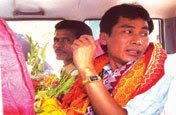Objectives:
The NDFB was formed with the purported objective of securing a ‘sovereign Bodoland’ in the areas north of the river Brahmaputra.
According to the ‘constitution’ of the outfit, which was adopted on March 10, 1998, nearly twelve years after its formation, the objectives of the outfit are the following.
- Liberate Bodoland from the Indian expansionism and occupation;
- Free the Bodo nation from the colonialist exploitation, oppression and domination;
- Establish a Democratic Socialist Society to promote Liberty, Equality and Fraternity; and
- Uphold the integrity and sovereignty of Bodoland.
Another significant demand of the NDFB concerns the script of the Bodo language. Currently, the Bodo language is written in Devnagri script; NDFB, whose members are mostly Christians and prefer to use the Roman script.
Leadership
The NDFB is headed by its 'chairman', Ranjan Daimary alias D R Nabla. However, in recent times, most of the outfit’s top leadership have either been arrested or have surrendered.
The 'vice president' Dhiren Boro was arrested in Gangtok, Sikkim's capital, on January 1, 2003. Its 'general secretary', B Swmkhwr alias Govinda Basumatary was arrested earlier, on November 25, 2002.
On June 5, 2004, Bhutan handed over the head of the NDFB’s ‘central headquarters’, Lt. B Udang alias Udang K R Brahma to the Indian authorities.
Finance secretary, Nileswar Basumatary alias B J Jabda surrendered to the Assam Police authorities in Guwahati on March 17, 2004.
NDFB’s ‘deputy commander-in-chief’, Bijoy Boro, was arrested in Bangkok during July 2004 and was subsequently deported to India. At present he is under the custody of the Assam Police.
The ‘publicity secretary', ‘Lieutenant’ B Irakdao is reported to be missing following the Bhutanese military operations in December 2003.
Areas of Operation
The areas in the north and northwest of the river Brahmaputra in Assam form the main expanse of operation of the outfit. The NDFB is traditionally active in the Bongaigaon, Kokrajhar, Darrang, Barpeta, Dhubri, Nalbari and Sonitpur districts. It is also known to be active in the Garo hills region of Meghalaya, close to the Assam-Meghalaya border.
In the year 2004, the outfit’s activities have been reported from Nalbari, Barpeta, Dhubri, Sonitpur, Kokrajhar, Bongaigaon, Chirang and Karbi Anglong districts.
Cadre Strength
Prior to the Bhutan operations, the strength of Bodoland Army, the armed wing of the NDFB, was estimated to be around 3500. Most of its cadres were based in the 12 camps located in southern Bhutan. However, a large number of cadres either surrendered or were arrested during and after the operations. The strength of the outfit, at present according to sources, is not expected to be more than 2000. Most of these cadres are based in the outfit’s camps in Myanmar and Bangladesh. Additionally, there are several temporary camps in different locations of Arunachal Pradesh and in the Garo hills region of Meghalaya.
Arms and Ammunition
The NDFB cadres have access to sophisticated arms and ammunition. They have been found to be using AK Series rifles, light machine guns, M-16 rifles, rocket propelled grenades, mortars and Chinese-made grenades. Cadres are trained in making and planting improvised explosive devices.
Linkages
The NDFB acts in collaboration with the ULFA. In addition, the NDFB shares a close relationship with the other outfits like the Kamatapur Liberation Organisation (KLO), the Achik National Volunteers Council (ANVC) and the National Socialist Council of Nagaland-Khaplang (NSCN-K). Unconfirmed reports also suggest linkages between the Maoists of Nepal and the NDFB.
According to a list submitted by the Indian authorities to their counterparts in Bangladesh, the NDFB maintains at least two camps in the Khagrachari and Tangail districts of that country.
Prior to its dislodgment from Bhutan, the outfit was reported to have established working relationship with certain elements in Bhutan. Several Bhutanese officials were reported to have visited the training camps located inside Bhutan and have been alleged to openly aiding the NDFB cadres.
NDFB, along with the ULFA, on various occasions was found to be allegedly channelling its funds through the "Bhutanese diplomatic bag" to their leaders based in Southeast Asian capitals.
The Chin National Liberation Army (CNLA), a militant outfit of Myanmar, has also supplied arms and ammunition to the NDFB in the past.
Negotiations for Peace
The NDFB, on October 8, 2004, announced a six-month long unilateral cease-fire with effect from October 15. The Government and security force operations continued against the outfit, amidst threats of a pull out by the outfit, did not reciprocate the move. At the end of the cease-fire period, the outfit further extended the truce on April 15. Meanwhile, the Assam Government released Govinda Basumatary, the arrested general secretary, to open a channel of communication with the outfit's top leadership reportedly based in Bangladesh. Several parleys between the outfit's leadership and representatives of the Union Government and Government of Assam were held in different parts of the State and New Delhi. It resulted in the signing of a tripartite cease-fire agreement on May 25, 2005, at New Delhi.




No comments:
Post a Comment